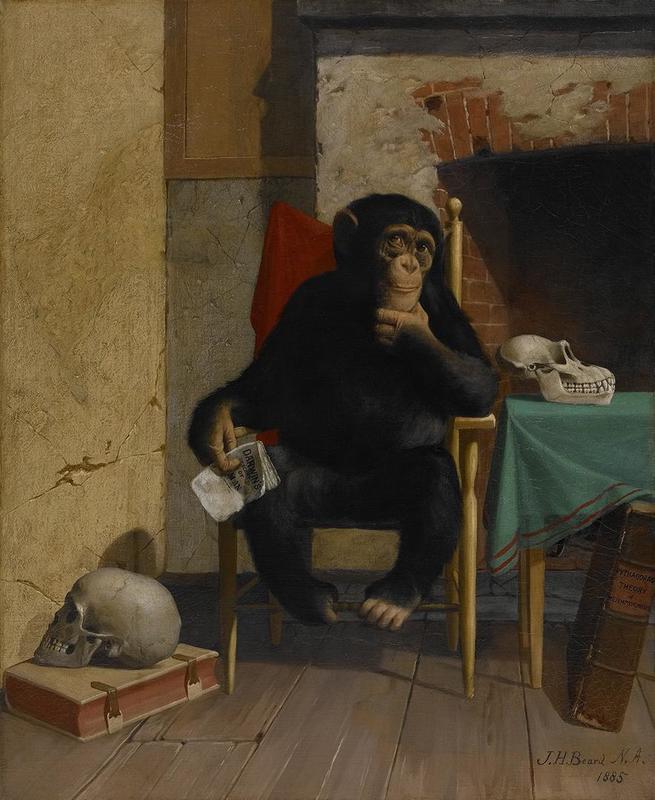More about "It Is Very Queer, Isn't It?"

Sr. Contributor
James Henry Beard was not the first artist to use animals (monkeys in particular) to represent human beings and their activities, nor would he be the last.
The use of a monkey taking on a human role in a painting belongs to a genre of art called singerie, from the French for "monkey tricks,” or “monkey games." Singerie was made popular during the 16th century, but its origins go back much further. Monkeys have been used as allegorical figures, as decorative additions in illuminated manuscripts, and in a variety of ancient art from Egyptian tombs, to friezes and sculptures in the Roman Empire.
Pieter van der Borcht (the Elder), a Flemish painter and engraver, can probably be credited with introducing singerie to a larger audience. In the 1560s-1570s he produced a series of 18 prints featuring monkeys, including monkeys doing laundry. The singerie monkeys were often used to poke fun at contemporary social values, human activities, and sometimes even specific people. In these paintings, monkeys frequently take on a human persona, sometimes (but not always) wearing human apparel and accessories. These monkeys have been depicted painting, sculpting, eating and drinking in taverns, playing games, attending school, running a barbershop, smoking, acting as players in a theater, and more.
The monkey (chimpanzee, to be exact) in "It Is Very Queer, Isn't It?", in the collection of the Crystal Bridges Museum of American Art, isn’t wearing any clothing that would make him appear to have human traits, but what about the way he’s sitting in that chair? There’s also the thoughtful look on his face, not to mention the copy of Descent of Man by Charles Darwin that he holds in his hand. The hefty book on the floor, Pythagoras’s Theory of Metempsychosis, is a heavy read for anyone, let alone a monkey.
So, just what is the chimp thinking about? We will likely never know the answer to that question. However, we do know that the painting is an actual "portrait” of a real chimpanzee whose home was at the zoo in Central Park, New York. The chimp had a name befitting one who might read those thick books: Remus Crowley, Esquire; yes, “Esquire,” although it’s unknown if Remus did, in fact, have a law degree. Most of the time, he would be referred to as simply “Mr. Crowley” by his friends. Mr. Crowley was probably a pretty popular chimp in the zoo, as there was even a book written about him. Of course, he was also the only chimp in the zoo, and was thought to be the first chimpanzee to arrive in the United States.
Being the only chimp in the zoo, Mr. Crowley was also lonely, and since these were the days before online dating, he was in kind of a tough spot. Luckily for Mr. Crowley, a man by the name of F.J. Johnson was looking out for him; in 1897, Johnson imported a female chimpanzee named Miss Kitty O’Brien (also known as “Kitty Banana”), for the purpose of becoming Mr. Crowley’s “wife,” according to the New York Times. Unfortunately, this arranged marriage had a sad ending; Mr. Crowley died the following year after struggling with pneumonia and consumption.
It’s worth noting that humans share close to 99% of our DNA with chimpanzees and Mr. Crowley, sitting there with both a human skull and a chimp skull in sight, might be wondering, in light of the world today, just who is the more intelligent species.
Sources
- Burns, Sarah. "Party Animals: Thomas Nast, William Holbrook Beard, and the Bears of Wall Street." American Art Journal 30, no. 1/2 (1999): 9-35.
- Fuller, Henry Starkey. Mr. Crowley of Central Park: a Historie, Being the Only Faithful and Authentic Narrative of the Capture of This Remarkable Chimpanzee in the Dark Continent of Africa, His Character in Public and Private: Also, That of Miss Kitty Ban
- Lee, Alexander. 2020. “Monkeys Natural Histories.” History Today 10 (2): 84–88. http://0-search.ebscohost.com.pacificatclassic.pacific.edu/login.aspx?d….
- “MR. CROWLEY'S BRIDE.; THE ARRIVAL OF MISS O'BRIEN FROM HER NATIVE JUNGLE.” The New York Times. The New York Times. https://timesmachine.nytimes.com/timesmachine/1887/06/29/100919390.html….
- PENNINGTON, ESTILL CURTIS, and ELLEN G. MILES. "JAMES HENRY BEARD: (1812–1893)." In Lessons in Likeness: Portrait Painters in Kentucky and the Ohio River Valley, 1802-1920, 108-09. University Press of Kentucky, 2011
- “The Sad True Story of Mister Crowley of Central Park.” Crystal Bridges Museum of American Art, November 30, 2017. https://crystalbridges.org/blog/the-sad-true-story-of-mister-crowley-of….
- Wong, Kate. “Tiny Genetic Differences between Humans and Other Primates Pervade the Genome.” Scientific American. Scientific American, September 1, 2014. https://www.scientificamerican.com/article/tiny-genetic-differences-bet…











